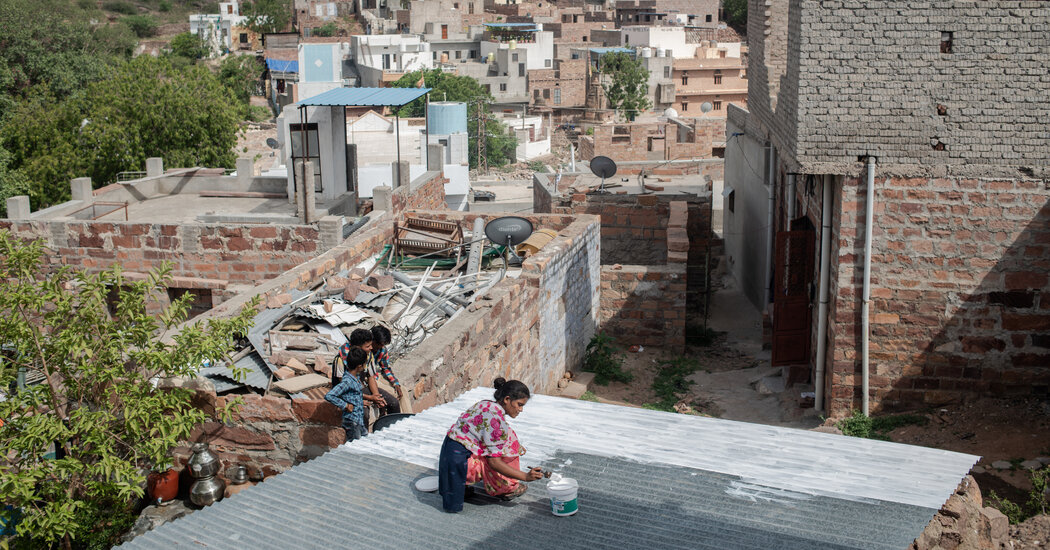Some hospitals in Uttar Pradesh have recorded higher-than-usual deaths as an unusually intense heatwave has gripped northern India for the past four days. Doctors there are convinced there is a link between the frigid temperatures and the deaths of patients, but officials are investigating the role the dangerous combination of heat and humidity played in the rise in the death rate.
In the Balea district, which has a population of about 3 million, the daily maximum temperature hovered around 43 degrees Celsius (109 degrees Fahrenheit) during the same period, 9 degrees higher than usual, and the relative humidity was as high as 53%. Hospitals there recorded dozens of deaths on June 15, 16 and 17.
Dr Jayant Kumar, the chief medical officer of the Balia district near Bihar, said 23 people died in the district on Thursday. The next day, 11 more surrendered. “The death toll is higher than normal,” Dr Kumar said.
On average, eight people die every day, he told news agency Press Trust of India. “Most of them were natural deaths,” he told The Times in a telephone interview. “Most of them were elderly people with different diseases such as diabetes.”
But Indian government officials objected to directly linking the deaths to the extreme heat.
Dr Diwakar Singh, the former chief medical director of the Balia district, told reporters on Friday night that 34 people at the main hospital under his watch died from heatstroke. The next day, he was reprimanded by the state government for reaching that conclusion prematurely and removed from office.
The government has since sent a scientific team from the state capital Lucknow to investigate the cause.
Dr Singh’s successor, Dr SK Yadav, took a more cautious approach on Sunday, saying: “Elderly patients with comorbidities such as hypertension and diabetes are dying from the heat.”
“Despite that,” he added in a telephone interview, “the death toll is higher than normal.” He agrees with Dr. Kumar’s assessment that overheating is to blame for the high death toll, whatever the exact link.
Dr Yadav said that while a large number of patients were admitted to hospital with fever, “we are able to provide beds for all patients and we have enough doctors and medicines.”
The nightmare of sudden temperature rises leading to mass mortality has taken on more urgency in recent years. The phenomenon in this part of the world may herald warnings beyond India’s borders.
The heat in this part of India has been hovering around the critical “wet bulb temperature” above which the human body cannot cool itself by sweating to a survivable temperature, defined as 35 degrees Celsius (95 degrees Fahrenheit), adjusted for 100 percent humidity . Barea had a wet-bulb reading of 34.15 degrees Celsius (about 93 degrees Fahrenheit) on Saturday.
Scientists say more elderly or frail patients are expected to die than usual from heat waves like this one, which climate change is making more common in India’s historically parched plains, as it is in much of the world same area.
The question is whether these are “excessive deaths” that can only be measured statistically, or whether India’s increasingly unbearable weather has played a more direct role in causing them, such as heat stroke. An excess is considered when more deaths are recorded than expected. But that leaves the question of what exactly causes them.
As many as 54 people have died in Balia and 44 in Bihar over the past three days, local newspapers collected data from various officials and hospitals.
In April, when temperatures in the western state of Maharashtra approached their peak, at least 11 people are known to have died from heat stroke almost simultaneously.
A particularly humid city like Calcutta now exceeds the expected human survival limit of the heat, cooling down by sweating only a few times a year; some epidemiologists are puzzled that more Indians are not dying from the heat.
The fact that wet-bulb temperatures have gradually approached critical levels in much of South Asia has attracted global attention over the past few years. It even found its way into literature. Kim Stanley Robinson’s 2020 science fiction novel The Ministry for the Future envisions a scenario in which 20 million Indian citizens — men, Women and children – caught in an intense week-long heat wave that instantly changed the course of history.
The hottest weather in the region comes every year in June. A cyclone, the Indian Ocean equivalent of a hurricane, tore through India’s west coast late last week, with rain expected to reach Uttar Pradesh and Bihar states in the next two days. This should bring the temperature down from the maximum level. Soon, the region will experience its annual monsoon.
A medical team from Lucknow is analyzing the diagnosis of excess deaths last week that may not have mentioned heatstroke. In that case, it would likely describe a situation such as the deadly heatwave that hit Chicago in July 1995 and claimed 700 lives, or the August 2003 heatwave that killed tens of thousands in Europe.
Needless to say, this type of weather is becoming more common on every continent, causing more people to die earlier than during colder periods.


